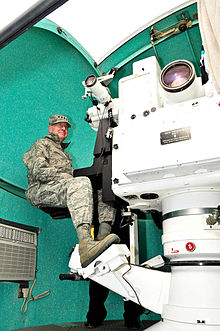- Cinetheodolite
-
The Air Force Space Command commander sits in a cinetheodolite at the Cape Canaveral Air Force Station

A cinetheodolite (a.k.a. kinetheodolite) is a photographic instrument for collection of trajectory data. It can be used to acquire data in the testing of missiles, rockets, projectiles, aircraft, and fire control systems; in the ripple firing of rockets, graze action tests, air burst fuze tests, and similar operations. Cinetheodolites provide angular measurements of the line of sight to the vehicle. This permits acquiring accurate position data. Together with timing systems, velocity and acceleration data can be developed from the position measurements. Cinetheodolites can serve as primary sources of position and velocity data to about 30 km slant range.
These instruments were developed from a family of optical devices known as theodolites by the addition of a movie camera, thus adding the ability to track the vehicle in flight and to obtain continuous trajectory data.
Contents
Introduction
One of the objectives of testing missile and rocket systems is to determine the actual "in-flight" performance of the vehicles themselves. One of the prime requirements for establishing the performance of vehicles in flight is to obtain accurate data which will reveal the position in space and the attitude of the vehicle during its trajectory. The employment of optics at a missile range may become highly significant in obtaining these data, if the atmosphere permits reasonably unobstructed observation, and if, moreover, an all-land test area makes possible optimum siting of instruments for most desirable look angles. Under these conditions, optics in general, and photogrammetry in particular, correlated with other instrumentation systems, can provide effective and accurate data of target trajectory.
Description
The cinetheodolite is a combination photo-recording and surveying instrument which tracks and photographs targets (in flight vehicles, etc.) at selectable frame rates. Some cinetheodolites have rate-aided tracking control, whereby an open loop servomechanism in conjunction with operator actuated hand wheels match the angular rates of the tracking axis with the angular rates of the target line of position.
Cinetheodolites consist of a stable base and bearing, a vertical gimbal or trunnion carrier which rotates about a vertical axis normal to the plane of the base; a central drum or housing which contains the system telescopic lenses, plus a camera and film assembly; a horizontal trunnion shaft on which the central drum is mounted so that it can rise or dip about the horizontal axis; and the sighting telescopes, which are also mounted on the horizontal trunnion shaft.
The first 3:43 of the flight of Apollo 11, filmed by a cinetheodolite
Manufacturers
Notable cinetheodolite manufacturers include Askania Werke Rathenow (Germany), Rheinmetall Air Defence (formerly Contraves AG, Switzerland), and BELOMO (Belarus).
References
Cinethrodolites, Materiel Test Procedure 5-1-031, White Sands Missile Range, 31 March 1969
Categories:- Measuring instruments
- Military aviation stubs
Wikimedia Foundation. 2010.


